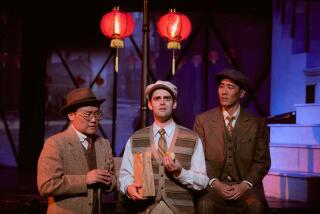Controversy reborn
- Share via
Before “The Passion of the Christ,” before “Fahrenheit 9/11,” there was “The Birth of a Nation.”
Mel Gibson’s and Michael Moore’s films overcame their explosive prerelease controversies to become two of the year’s most popular films, but “The Birth of a Nation,” D.W. Griffith’s 1915 silent Civil War epic, still provokes such volatile reaction that it is rarely shown publicly.
Though “The Birth of a Nation” has been available for years on home video, many of its scenes have so incensed audiences that even college professors are reluctant to show it in class. Blacks are depicted as buffoons and rapists. White actors in blackface pose as congressmen, eating fried chicken and watermelon on the floor of the House. The hooded riders of the Ku Klux Klan are portrayed as heroes of the Reconstruction era.
Nevertheless, on the eve of its 90th anniversary, “The Birth of a Nation” is experiencing a mini-renaissance among artists, scholars and film lovers who deplore its racism but applaud its cinematic achievements, saying the film not only has historical significance but can also provide perspective on current race relations and politics.
Charlie Lustman, the owner of the Silent Movie Theatre on Fairfax Avenue, is screening the film Monday night to launch a series of rare and important silent films. The event comes almost exactly four years after he last tried to show the film, in conjunction with the 2000 Democratic National Convention.
At that time, Lustman defended the film as “a cultural and artistic monument of the silent screen” while acknowledging its portrayal of blacks as “a shameful stain on the history of our country and its heritage.” But he pulled the film after pressure from the National Assn. for the Advancement of Colored People as well as threats from others.
Fearing that the screenings in 2000 would provoke hate crimes, Geraldine Washington, president of the Los Angeles branch of the NAACP, said in an interview in The Times: “Los Angeles, with its multicultural population, is trying to come together as a people, and to show this film certainly presents a danger that some people might be hinted to go out and get involved in some of these racist actions. We certainly don’t want that.”
Instead of “The Birth of a Nation,” Lustman showed Griffith’s less volatile 1916 “Intolerance,” which explores the historical and personal effects of prejudice.
Though he sympathizes with those who are angered by “The Birth of a Nation” (“It glorifies the rise of hatred”), Lustman now says the film is “perfect” to kick off the rare silent series. “I’m very serious about this Monday series, and I thought, why not start it out with the biggest and most cinematic gem in history?”
In addition to the Silent Movie Theatre’s one-nighter, New York City-based Paul Miller, a musician, conceptual artist and writer who performs under the name “DJ Spooky That Subliminal Kid,” is taking a “remix” of “The Birth of a Nation” on an international tour. Using footage from the film, graphics, special effects and an original score, Miller’s “Rebirth of a Nation” had its premiere last month at Lincoln Center and will be performed in several other U.S. cities as well as in Europe and Britain. (A Los Angeles date is not scheduled.)
“As an artist, I feel I can make cultural statements about race in using the film,” Miller said. “The movie shows how race was used to raise fear and paranoia among whites. There are scenes of black voters being turned away from the polls, and I think that’s fascinating given the current political climate surrounding the election.”
In his review in the New York Times, Jon Pareles called the idea behind “Rebirth of a Nation” promising but concluded that the production de-emphasized the original film’s racism rather than highlighting it. “The most stereotypically racist sequence, a meeting of a black-dominated House of Representatives, was almost completely obscured by overlays,” he wrote.
Film critic Roger Ebert calls “The Birth of a Nation” a “great movie” in an essay in his upcoming book, “The Great Movies II,” saying the shot of the battle charge is the most beautiful he’s seen.
But he notes that “racism of the sort seen in ‘The Birth of a Nation’ has not been acceptable for decades.... ‘Birth of a Nation’ is unapologetic about its attitudes, which are those of a white Southerner, raised in the 19th century, unable to see African-Americans as fellow beings of worth and rights.”
In recent years the film has been a popular item on home video. Brett Wood, producer of Kino on Video’s 2002 DVD box set of Griffith’s works, including “The Birth of a Nation,” maintains that it remains as powerful today as when it was first shown to audiences.
“After all this time, this is still a very effective and well-made movie,” he said. “If it were just gross caricatures, it could be dismissed. But it’s really an engrossing film that works subtly. It has to be handled and viewed with care. It would seem like the furor would have died down all these years later, but it still manages to raise up the emotions.”
Vivian Sobchack, associate dean of the UCLA School of Theater, Film and Television and a critical studies professor, echoed Wood’s assessment of the film: “In relation to those who lean to the left, it’s a very incendiary film. But it’s also exciting and has a real command of the melodramatic form. If it were less commanding, it would be less volatile.”
In addition to being a box-office hit, the film sparked a firestorm when it was first released. According to the book “A Short History of the Movies” by film scholar Gerald Mast, the NAACP, the president of Harvard University and liberal politicians all blasted the film for its racist perspective. Some cities, fearing race riots, refused to allow it to be shown.
“At a revival of the film some ten years after its original opening, mobs poured into Chicago to see it as well as to attend a Ku Klux Klan convention,” Mast wrote.
One of the extras of the Kino DVD version is a documentary, “New York vs. The Birth of a Nation,” which documents the battles over the film’s 1922 re-release, including protests by the NAACP and a montage of scenes ordered cut by the New York Censor Board.
Monday night, the presentation of the three-hour film will be accompanied by 92-year-old organist Bob Mitchell and will be introduced by film scholar and preservationist David Shepard, who will also show rare outtakes.
Lustman said the showing will include a disclaimer that he does not endorse the content of the film but wants to honor its place in cinema history.
The “deplorable” racism in “The Birth of a Nation,” Lustman said, is intertwined with some of the most realistic and groundbreaking moments in cinema. “The battle scenes and the shooting of Lincoln in the opera house are so realistic they’re amazing. They’re phenomenal re-creations. Griffith was the first one to use close-ups. And it’s historically correct from the perspective of a Southerner who lost the war.”
As of Friday, no organized protest had developed, though the NAACP’s Geraldine Washington said she still opposes showing the film.
“This movie has no positive value whatsoever,” she said. “And it runs the risk of creating unrest and hate crimes. It’s just too risky to take a chance.”
But the show will go on, Lustman said. “It’s what I’m supposed to do. There’s no turning back. I’m running it.”
More to Read
Only good movies
Get the Indie Focus newsletter, Mark Olsen's weekly guide to the world of cinema.
You may occasionally receive promotional content from the Los Angeles Times.











